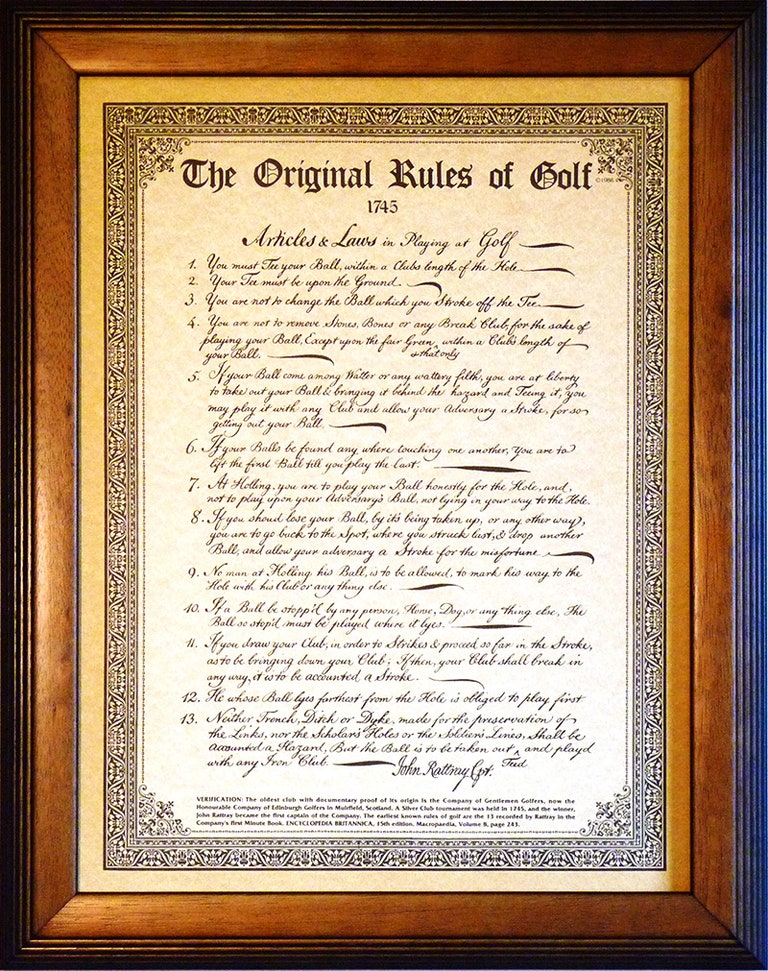The Coronavirus pandemic has hit a giant pause button on fans being able to watch golf on TV, and in some cases, even kept people off courses. But while we hunker down and hope for a speedy return to normalcy, we can also use this time as an opportunity to learn more about the game we love. Here’s our latest installment of “Did you know?”
Break out your modern, handy dandy Rules of Golf book and as you begin reading you'll find yourself asking the question "is this going to be on the mid-term?" It's confusing. It's complex. It's long. And it's still that way even after the rules were supposedly "simplified" in 2019. It's how we came up with a whopping 21 painful rules incidents that occurred last year alone.
DID YOU KNOW: How the term "birdie" came to be
Of course, the rules weren't always this maddening. In fact, they were actually so incredibly simple that they fit on one page. OK, so it was one really big page with that old-school script writing since they were created in 1744 (!!).
That's right, 276 years ago this month the Original Rules of Golf were drafted by the Honourable Company of Edinburgh Golfers, who sought out to create a set of rules for the world's first "open" golf competition. According to scottishgolfhistory.com, they were drawn up at the behest of the City of Edinburgh Council, who agreed to present the Silver Golf Club prize to the winner of the competition as long as there was a written set of rules.
That original set included just 13 rules, as opposed to the 24 there are today, each with their own subset of rules. Here is a photo of the original set that some golf fanatics may recognize since they probably already have it framed on their wall at home (guilty):
 FacebookPinterest
FacebookPinterestFor those having trouble reading the handwriting, the Original Rules of Golf as they were originally written are as follows:
1.) You must Tee your Ball within a Club's length of the Hole.
2.) Your Tee must be upon the Ground.
3.) You are not to change the Ball which you Strike off the Tee.
4.) You are not to remove Stones, Bones or any Break Club, for the sake of playing your Ball, except upon the fair Green within a Club's length of your Ball.
5.) If your Ball comes among watter, or any wattery filth, you are at liberty to take out your Ball & bringing it behind the hazard and Teeing it, you may play it with any Club and allow your Adversary a Stroke for so getting out your Ball.
6.) If your Balls be found any where touching one another, You are to lift the first Ball, till you play the last.
7.) At Holling, you are to play your Ball honestly for the Hole, and not to play upon your Adversary’s Ball, not lying in your way to the Hole.
8.) If you should lose your Ball, by its being taken up, or any other way, you are to go back to the Spot, where you struck last, & drop another Ball, And allow your adversary a Stroke for the misfortune.
9.) No man at Holling his Ball, is to be allowed, to mark his way to the Hole with his Club, or anything else.
10.) If a Ball be stopp’d by any Person, Horse, Dog or anything else, The Ball so stop’d must be play’d where it lyes.
11.) If you draw your Club in Order to Strike, & proceed so far in the Stroke as to be bringing down your Club; If then, your Club shall break, in any way, it is to be Accounted a Stroke.
12.) He whose Ball lyes farthest from the Hole is obliged to play first.
13.) Neither Trench, Ditch or Dyke, made for the preservation of the Links, nor the Scholar's Holes, or the Soldier's Lines, Shall be accounted a Hazard; But the Ball is to be taken outand play’d with any Iron Club.
As you may have noticed at the bottom of the photo, the page was signed by "John Rattray Cpt.". Rattray was the first winner of the 11-man competition and because of that was named "the Captain of the Golf" on April 2, 1744. Not a bad title for a first-time winner!
Amazingly, many of the Original Rules still exist almost 300 years later, though with much different wording. It'd be a lot cooler if we brought back "watter" with two T's, "stopp'd" with two P's and "holling" with two L's.
Ten years after the Original Rules were written for the competition at Leith Links, the golfers at St Andrews, which would later become known as the Royal & Ancient Golf Club of St Andrews, adopted the rules for their own competition. However, two amendments were made to Rule No.'s 5 and 13. Rule No. 5 was changed so that you could not tee the ball behind the hazard and so that you had to throw it at least six yards behind the hazard, while Rule No. 13 was changed so that you could tee it.
There has been countless changes, additions and revisions since, many of which can be found in this brief history of the Revisions to the Rules of Golf: 1744 to Present. Technically, the modern rules still fit on one page, though that page requires a lot of scrolling, clicking and refreshing.

